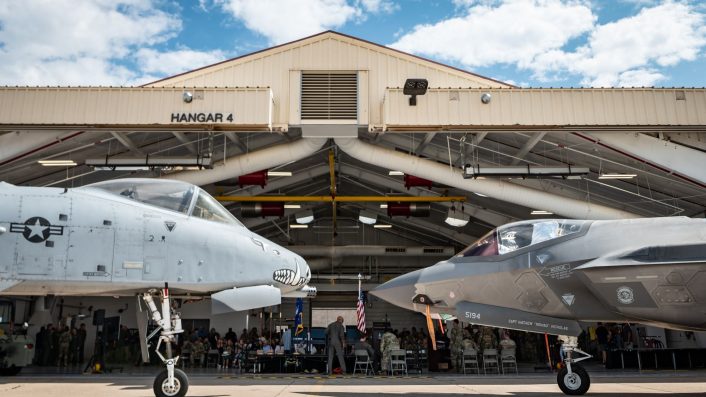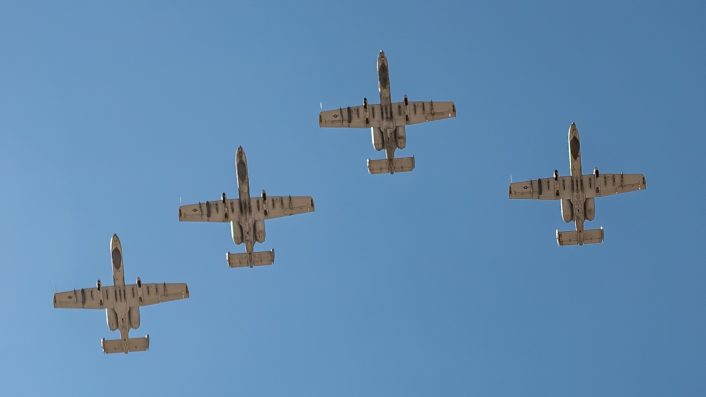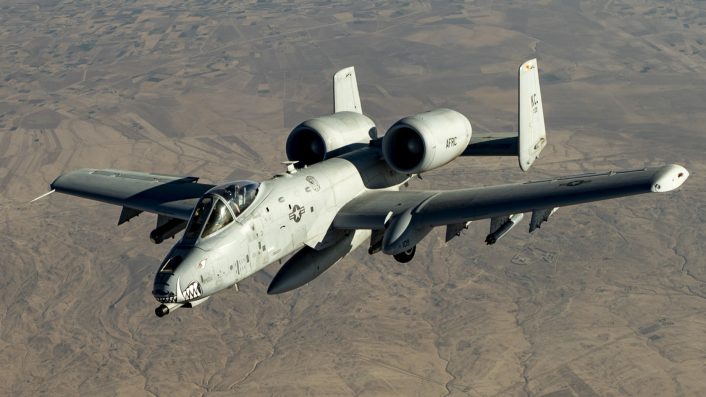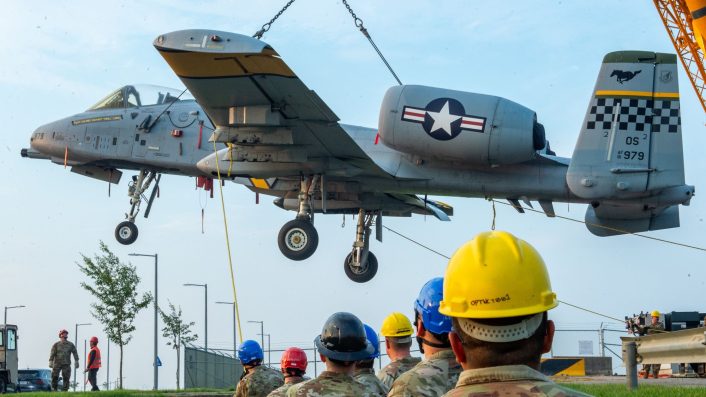First established during World War Two, the 924th Fighter Group was deactivated as part of the ongoing A-10 divestment.
The 924th Fighter Group (FG) at Davis-Monthan AFB, Arizona, closed a storied chapter when it was deactivated on Sep. 6, 2025, amid the A-10C Thunderbolt II’s (also known as Warthog) broader divestment by the U.S. Air Force. The 924th FG oversees the 47th Fighter Squadron, which was the Air Force Reserve Command’s (AFRC) Formal Training Unit for the A-10C, and is now slated to receive the F-35A Lightning II.
The ceremony, held at Davis-Monthan AFB in the presence of Airmen, families, retired personnel and senior officers, honored the “enduring heritage, from the squadron’s first combat missions over Oahu in 1941, to its modern deployments, Hawgsmoke competition triumphs, and final A-10 flights.” The 47th FS is also known as the “Dogpatch”, and its A-10Cs feature the nose art representing its nickname, “Terrible Termites.”
The customized livery on each of its A-10s’ noses represent its service from the Pacific battlefields during World War Two, to the desert ranges of Arizona.

Deactivation Ceremony
In the press release, retired Maj. Gen. Bruce “Lite” Miller, former 10th Air Force commander, had an upbeat message. “This is supposed to be a celebration. Today we’re doing an inactivation, which has a sense of permanence – the loss of the A-10. It’s just the end of an era,” said Miller.
Lt. Col. Meredith “Xena” Morris, commander of the 924th Maintenance Squadron (924th MS) – another unit under the 924th FG, called the unit’s members an “elite family” which kept the unit “in its prime.” Col. Russell “Runz” Fette, 924th Operations Support Flight and 47th Fighter Squadron commander, carried the story back to the group’s World War II roots.
He recalled the 47th’s fight during the attack on Pearl Harbor on Dec. 7, 1941. About the unit’s distinct aircraft livery, Fette said they are “the only unit still allowed this unique individual aircraft art.” Col. Aaron “Nacho” Weedman, 924th Fighter Group commander, praised the unit’s resilience “through every chapter of its lineage.”

“I wanted to retire the A-10 and honor your legacy,” Weedman said. Col. Todd “Riddler” Riddle, 944th Fighter Wing commander and former A-10 pilot, acknowledged the challenges of closing a fighter group.
With plans underway to activate the 47th Fighter Squadron in the F-35 community, leaders encouraged Airmen to carry forward the traditions that define the unit’s spirit. The ceremony saw an F-35A from Eglin AFB’s 60th FS and an A-10C from the 47th FS parked nose-to-nose in front of the hangar where the ceremony was held. Four A-10s from the unit also conducted a “final flyover” to mark the event.
🇺🇸 An A-10 Thunderbolt II from the 47th Fighter Squadron sits on the flightline at Marine Corps Base Hawaii, July 30, 2024, during the unit’s participation in Rim of the Pacific (RIMPAC) 2024.
(📸/U.S. Air Force Photo by MSgt Courtney Richardson) pic.twitter.com/qKu6dmYnm2
— Guy Plopsky (@GuyPlopsky) December 7, 2024
924th FG and 47th FS history
The 924th FG was established in 1962 as the 924th Troop Carrier Group under Continental Air Command, flying C-119 Flying Boxcars at Ellington AFB, Texas. Between 1962 and present, the unit changed missions and aircraft several times. It flew experimental drop missions for NASA; flew the C-130 Hercules to Vietnam; operated the F-4D Phantom II; converted to the F-16A Fighting Falcon in 1991, followed by the F-16C in 1994 while becoming the 924th Fighter Wing.
The 924th FW was deactivated in September 1996 and was reactivated on Jan. 1, 2011 as the 924th Fighter Group at Davis-Monthan AFB under the Air Force Reserve Command. Between October 2013 and March 2014, the 924th FG gained 28 A-10s aircraft from Barksdale Air Force Base, Louisiana.
A 47FS A-10C over Barry’s Range (ssgt Noah D. Coger) pic.twitter.com/f3LLeMczKx
— J.J. (@kadonkey) August 10, 2025
The 47th FS was established on Dec. 1, 1940, as the 47th Pursuit Squadron, assigned to the 15th Pursuit Group at Wheeler Field, Hawaii. Until 1945, the 47th flew the P-26, P-36 Hawk, P-47 Thunderbolt, and P-51 Mustang aircraft, shooting down eight Japanese aircraft on Dec. 7, 1941, and 100 more by the end of the war. It then returned to Hawaii and was inactivated on Oct. 15, 1946.
From Dec. 1, 1952, to Oct. 1, 2013, the 47th was re-activated and deactivated several times, flying the North American F-86L Sabre, F-102 Delta Daggers, F-84F Thunderstreak, F-4 Phantom II, A-37 Dragonfly and finally the A-10. On Oct. 1, 2013, the 917 FG and the 47th once again deactivated. On Mar. 1, 2014, the 47th stood up again as an Air Force Reserve A-10 formal training unit under the 924th FG at Davis-Monthan AFB.
#47の日
47th Fighter Squadron “Dogpatchers”
機首のホッグティースがカッコいい予備役部隊🐗
長らくルイジアナ州Barksdale AFBに所在しており写真のA-10もBD所属(2003年9月撮影)
親部隊の917WGは2011年に解散し47FSはアリゾナ州DavisMonthanAFBに移動しています。#パッチセラピー pic.twitter.com/V5Oi1l95wF
— Luke GETSNO (@lukegetsno) April 7, 2024
A-10 retirements in the USAF
The 924th Fighter Group is within the administrative control of the 944th Fighter Wing, but is operationally associated with the 355th FW. The 47th Fighter Squadron and the 924th Maintenance Squadron are two of the major units overseen by the 924th FG. From the beginning of 2025 to August, the USAF has divested 41 A-10Cs to the 309th AMARG (Aerospace Maintenance and Regeneration Squadron) at Davis-Monthan AFB, as per the latest records.
Specifically, the 47th FS has transferred four A-10Cs to the “boneyard” since 2013, with the latest two being divested on Mar. 6, 2024 and Jun. 14, 2024, and the two others on Apr. 9 and Jun. 26, 2013. On May 27, 2025, the 124th FW of the Idaho Air National Guard also started officially decommissioning its A-10C Thunderbolt IIs, with the first jet departing the base on that day for the 309th AMARG.

The unit is also receiving Thunderbolts from other units to maintain a complete fleet during the transition, and retain its focus on projecting global airpower while preparing for contingencies. The aircraft is also still operational over the CENTCOM (Central Command) AOR (Area of Responsibility), given the traditional US commitment to the region for the last two decades and multiple recurring flashpoints.
On Aug. 2, 2025 the 25th FS, based at South Korea’s Osan Air Base, also retired one of its A-10Cs by installing the divested airframe (81-0979), on a traffic circle at Camp Humphreys. Part of the 51st FW, the unit participated in its last “Buddy Squadron” training exercise with the RoKAF (Republic of Korea Air Force) late in January 2025, before the type started withdrawal from the country.

Defense One also reported on Jun. 30 that the U.S. Air Force wants to “get rid” of its remaining A-10s by 2026 “rather than gradually phase them out” to open up “funding for new weapons.” The service’s FY26 budget requests aims to divert funds to the F-47 NGAD, by also halving its F-35 buy to 24 units, and seeking Congress’s approval to divest 162 A-10s.









